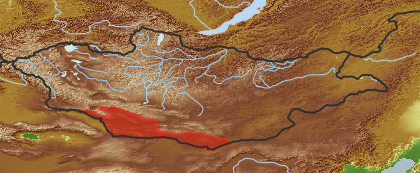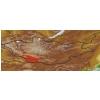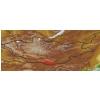| Class: | angiosperms |
| Order: | Rosales |
| Family: | Elaeagnaceae |
| Genus: | Elaeagnus |
| Scientific name: | Elaeagnus moorcroftii Wall. ex Schlecht. |
| Name acc. to: | Gubanov 1996 |
| Herbar: | list records  |
| Description: | Shrub covered with silvery scales. Leaves simple, alternate, lanceolate to elliptic or ovate, 20-50 x 8-15 mm, petiolate. Flowers axillary, 1-3 on drooping pedicels, bisexual, tetramerous. Fruits oval, 8-10 mm long, dry. |
| Comments: | According to IPNI E. moocroftii is a synonym of E. angustifolia. Many taxa of Elaeagnus are separated only by quantitative characters. Better information on variation within populations is likely to lead to a significant reduction in the number of species recognized. |
| Link to Flora of China: | http://www.efloras.org/browse.aspx?flora_id=2&name_str=Elaeagnus |
| open map in a new window |  |
| Habitat: | Sandy oases (Grubov 2001). |
| Habit (i)general appearance of a plant | |
| Growth form: (i)Herb, shrub, tree or climber. | shrub, subshrub or semishrub (i)Shrub, multi-stemmed, mostly (0.2) 0.5 - 5 m high, shoots woody up to the tip
example: Caragana leucophloea 
|
| Parasite status: (i)Is the plant a half- or full parasite? | no parasite/saprophyte (i)Plant fully autonomous, leaves with chlorophyll
example: Most plants, Ranunculus  inherited by family Elaeagnaceae: no parasite/saprophyte inherited by family Elaeagnaceae: no parasite/saprophyte
|
| Water or terrestrial plant: (i)Where do the plants grow? | terrestrial (i)Plant grows on dry land
example: Orostachys spinosa  inherited by family Elaeagnaceae: terrestrial inherited by family Elaeagnaceae: terrestrial
|
| Leaf (i)expanded, usually photosynthetic organ of a plant (including phylloclades) | |
| Leaf development: (i)Structure and development of leaves. | with green leaves (i)Plant with green leaves  inherited by family Elaeagnaceae: with green leaves inherited by family Elaeagnaceae: with green leaves
|
| Simple or divided leaves: (i)Are the leaves simple or completely divided in several parts? Blade of the leaf entire or (more or less) deeply dissected. Attention: There are various appearances of the leaf margin (from entire to toothed and lobed). Here, we ignore this and ask only for dissections that separate the leaf for more than one third of its length or width, whatever is smaller. Sometimes, it is difficult to tell apart compound leaves from a shoot system with simple leaves: look for stipulae and/or axillary buds at the ground of the leaves: if only some possess these structures, the others are most likely leaflets of a compound leaf. | simple (i)Non-divided leaf, but margin may be incised nearly to the ground   inherited by family Elaeagnaceae: simple inherited by family Elaeagnaceae: simple
|
| Shape of blade: (i)Easy for simple leaves. In compound leaves use the general shape of leaflet. Always check the ground for largest leaves of a plant. To be worked out: how to handle pinnate leaves? | elliptic (including ovate and obovate) (i)Elliptic: broadest at the middle and narrower at the two equal ends; ovate: egg-shaped, attached at the broad end; obovate: attached at the narrower end
example: Limosella aquatica 
lanceolate (i)Lance-shaped; much longer than wide, with the widest point in the middle or below 
|
| Length of leaves: (i)How long is the leaf, be carefull in compound leaves, measure the complete leaf. | from 21 mm to 50 mm
|
| Leaf margin: (i)Structure of leaf margin (or that of a leaflet in case of compound leaves). Attention: Here we ask for the leaf margin, defined as all those dissections that separate the leaf for less than one third of its length or width, whatever is smaller. To be worked out: how to handle margin of pinnate leaves? | entire (i)Plain margin, not toothed
example: Iris   inherited by family Elaeagnaceae: entire inherited by family Elaeagnaceae: entire
|
| Petiole: (i)Leaf divided into stalk (petiole) and blade. | with (i)Leaves with petiole (stalk) 
shorter than blade (i)Petiol shorter than leaf blade
|
| Stipule: (i)Leaflets at the base of the petiole, these are smaller and of different shape. | none (i)Without stipules
example: Euphorbia, Ericaceae s.l.  inherited by family Elaeagnaceae: none inherited by family Elaeagnaceae: none
|
| Leaf colour upper side: (i)Shades of green on the leaf, upper side. | green (i)Clear green
example: Tribulus terrestris
grayish (i)Grayish in colour due to hairs or a thick cuticula
|
| Leaf colour lower side: (i)Shades of green on the leaf, lower side. | grayish (i)Grayish in colour due to hairs or a thick cuticula
example: Atriplex cana  inherited by family Elaeagnaceae: grayish inherited by family Elaeagnaceae: grayish
|
| Leaf veination: (i)Arrangement of the main veins of a leaf. | pinnate (i)One main vein, several side veins, sometimes inconspicuous
example: Cicerbita     inherited by family Elaeagnaceae: pinnate inherited by family Elaeagnaceae: pinnate
|
| Flower (i)reproductive portion of the plant, consisting of sepals, petals, stamens, and pistils | |
| Flower appearance and pollination: (i)General appearance of the flower. | not attractive, wind-pollinated or some water plants (i)Small, colourless or green flowers
example: Betula, grasslike plants: Carex, Setaria, Juncus  inherited by family Elaeagnaceae: not attractive, wind-pollinated or some water plants inherited by family Elaeagnaceae: not attractive, wind-pollinated or some water plants
|
| Perianth arrangement: (i)Attention: in some plants, flowers may be dimorphic in different ways (dioecious or gynodioecious). If flowers vary, record the characters of the most showy flowers. | simple, similar (i)Only one type of perianth leaves (tepals)
example: Tulipa   inherited by family Elaeagnaceae: simple, similar inherited by family Elaeagnaceae: simple, similar
|
| Diameter of flower: (i)Diameter of flower or flower head. | to 5 mm (i)
example: Aruncus  inherited by family Elaeagnaceae: inherited by family Elaeagnaceae:
from 5 mm to 10 mm (i)
example: Stellaria  inherited by family Elaeagnaceae: inherited by family Elaeagnaceae:
|
| Flower symmetry: (i)Symmetry of the perianth leaves. Attention: to assess this character, look on sepals, petals and stamens, but neglect carpels and ovary. | radiary, regular (actinomorphic) (i)More than two axis of symmetry
example: Saxifraga: 5; Iris: 3   inherited by family Elaeagnaceae: radiary, regular (actinomorphic) inherited by family Elaeagnaceae: radiary, regular (actinomorphic)
|
| Petal / Tepal number: (i)Number of petal leaves (inner perianth leaves, usually coloured). | 4 (i)
example: Galium
|
| Petal / Tepal fusion: (i)To which degree are the petal leaves connected? Petals sympetalous. | free (i)all petal leaves separate from each other
example: Anthriscus  inherited by family Elaeagnaceae: free inherited by family Elaeagnaceae: free
|
| Spur: (i)A hollow, slender, sac-like appendage of the perianth leaves, storing nectar. | no spur (i)Flower without appendage
example: Peganum  inherited by family Elaeagnaceae: no spur inherited by family Elaeagnaceae: no spur
|
| Stamen number: (i)Attention: We ask for the reproductive organs of the flower dispersing pollen. Count only fully fertile stamens, not staminodia (e.g. Parnassia). | 4 (i)Extremely rare, may be absent
example: Plantago  inherited by family Elaeagnaceae: 4 inherited by family Elaeagnaceae: 4
7-9 (i)
example: Trientalis, Sedum  inherited by family Elaeagnaceae: 7-9 inherited by family Elaeagnaceae: 7-9
|
| Stamen fusion: (i)To which degree are the stamens fused? Attention: Whereas the pollen sacs itself are often free., their stalks (filaments) may be fused. Here, we count them as fused if they are together over at least one thirth of their length. | free (i)Stamens with separate bases
example: Malus  inherited by family Elaeagnaceae: free inherited by family Elaeagnaceae: free
|
| Pistil number: (i)Number of pistils (female floral organs: style, if developed; stigma and carpels/ovary together build the pistil). | 1 (i)One carpel, but clearly one stigma
example: Pyrola, Primula, Alyssum  inherited by family Elaeagnaceae: 1 inherited by family Elaeagnaceae: 1
|
| Style number: (i)Portion of the pistil connecting the stigma to the ovary. | 1  inherited by family Elaeagnaceae: 1 inherited by family Elaeagnaceae: 1
|
| Stigma number per style: (i)Number of stigmas per style. | 1 (i)One stigma, sessile or with a developed style  inherited by family Elaeagnaceae: 1 inherited by family Elaeagnaceae: 1
|
| Ovary position: (i)For entirely or partly fused carpels, describe their position in relation to the insertion point of perianth leaves (best done by doing a longitudinal section of a flower). | superior (hypogynous) (i)Base of carpels attached above insertion point of perianth leaves, carpels free or fused
example: Delphinium, Anemone    inherited by family Elaeagnaceae: superior (hypogynous) inherited by family Elaeagnaceae: superior (hypogynous)
|
| Sex: (i)Distribution of male and female organs among flowers, only most commonly cases. | bisexual, hermaphrodite (i)All or nearly all flowers of a plant with male and female parts
example: Haplophyllum, Chenopodium
|
| Fruit (i)the seed bearing organ, with or without adnate parts; a ripened ovary and any other structures which are attached and ripen with it. Aggregate fruits are handled like simple fruits for determination. | |
| Consistency: (i)Fleshy fruits or dry fruits, see dispersal adaptations for further classification. | dry (i)With a dry outer shell, no fleshy parts, but seed (embryo) could be edible
|
| Type of fruit: (i)Common fruit types (including pseudocarp). | Indehiscent fruits  inherited by family Elaeagnaceae: Indehiscent fruits inherited by family Elaeagnaceae: Indehiscent fruits
Solitary fruits (i)     inherited by family Elaeagnaceae: Solitary fruits inherited by family Elaeagnaceae: Solitary fruits
drupe (stone fruit) (i)Fleshy, indehiscent fruit with a single, hard stone inside
example: Plum, cherry   inherited by family Elaeagnaceae: drupe (stone fruit) inherited by family Elaeagnaceae: drupe (stone fruit)
|
| Opening of fruit: (i)Mode of dehiscence at maturity to release seeds. | not opening / indehiscent (i)Fruits remain closed at maturity and disperse with seeds inside
example: Corylus (nut), Vaccinium (berry)  inherited by family Elaeagnaceae: not opening / indehiscent inherited by family Elaeagnaceae: not opening / indehiscent
|
| Seed number: (i)Estimate the number of seeds per fruit, if recognizable seeds are in the fruit (in rare cases a fruit may contain one seeded nuts: rose hip, carex). | 1 (i)A single seed (stone) or seed and fruit wall tightly connected
example: Prunus, Amygdalus: drupe  inherited by family Elaeagnaceae: 1 inherited by family Elaeagnaceae: 1
|
| Root / shoot below ground (i)plant part below ground (in most cases), including below ground shoots, without leaves | |
| Root type: (i)Organisation of the roots. | allorhizous (i)Plant with a conspicuous tap root, one larger tap root with side roots
example: Dicotyledonae  inherited by order Rosales: allorhizous inherited by order Rosales: allorhizous
|
| Distribution (i)region where the plant is likely to be found | |
| Distribution (Veg. Zones): (i)acc. to Grubov 1952 | Transaltai Gobi (i)In distribution data often named as '15' 
Alashan Gobi (i)In distribution data often named as '16' 
acc. to: Gubanov 1996 |
| Plant Status | |
| Red list status: (i)Rare Mongolian plants | Critically Endangered (Nyambayar et al. 2011) (i)Very rare
example: Dactylorhiza fuchsii
very rare (Shiirevdamba 2007) (i)Very rare plant
|